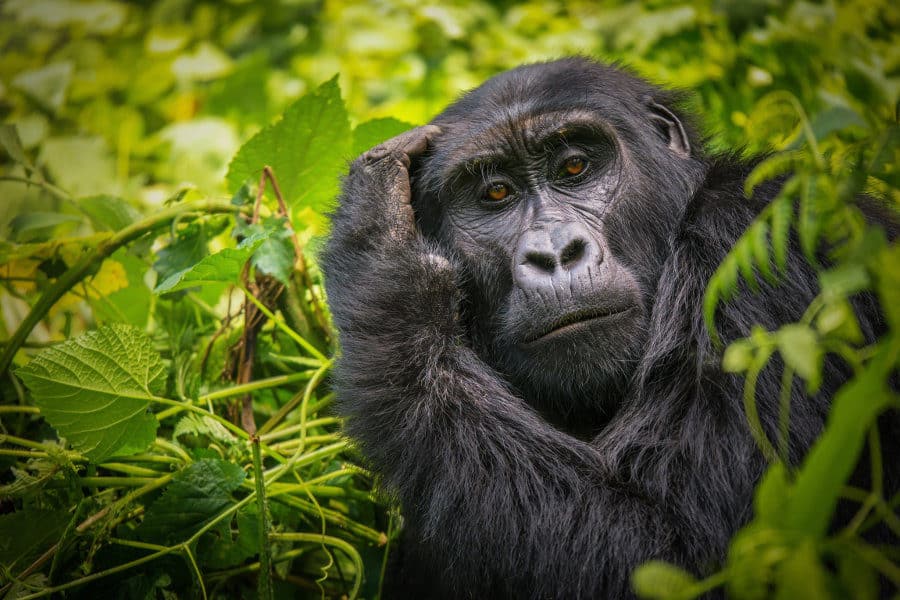The northern white rhino is an icon of our times. Beautiful yet bashful, these rhinos now represent the greed of mankind and devastation of an animal species. Sadly, northern white rhinos are extinct in the wild.
In 2009 the final four northern white rhinos were relocated from zoos to Ol Pejeta Conservancy in Kenya. Two females remain. Two males, Suni and Sudan, have since died. Soon there will be no more of these rhinos.
But why was the plight of northern white rhinos so severe? And what can we all learn from this sad wildlife tale?
What is the Northern White Rhino?
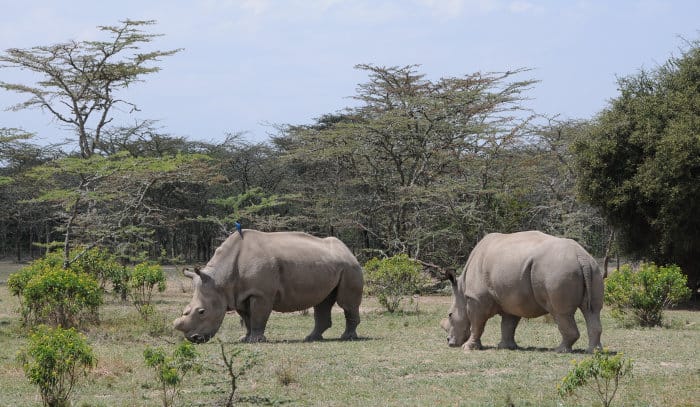
The northern white rhino is one of the two subspecies of white rhino native to Africa. Southern white rhinos are the most abundant rhino species, although even these are at risk of extinction.
Africa is also home to four black rhino subspecies (one is extinct), while three rhino species just about hang on in Asia: greater one-horned, Sumatran and Javan.
Historically, northern white rhinos were native to countries in Central Africa, including Uganda, Chad, Sudan, the Central African Republic and DRC. They drink twice a day so lived close to water sources, such as along riverbanks.
Northern white rhinos are grazers so need ample access to fresh grass and thick bush covers. Despite their enormous size, they are shy animals and prefer to hide away. Their typical habitat is dense forest, savannah and woodland, where they will also eat fruits, leaves, stems, seeds, nuts and flowers.
Both species of white rhinos are known as mega grazers. They are incredibly beneficial to humans because they increase the biodiversity of grasses. By grazing the grasses to a short length, rhinos also stop the spread of wildfire.
The northern subspecies is smaller and lighter than its southern cousin. They range from 1000-3000 kg and measure some 3.5 metres in length. Unfortunately, there has never been any significant quantitative data about this subspecies, so not much is known about their physical description.
Northern white rhinos are hairier than their southern counterparts and develop this hair from an earlier age. They can live 40-45 years in the wild but only around 30 years in captivity.
An Early History of Northern White Rhinos
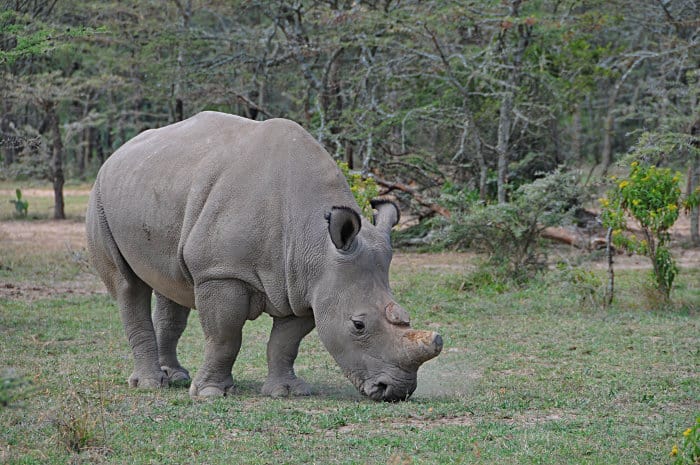
Human understanding of northern white rhinos has always been poor. And that understanding isn’t going to improve now that only two of the species remain.
White rhinos split into two subspecies approximately 1 million years ago. One species adapted to the wide open spaces of southern Africa, while the other evolved to thrive in the denser landscapes of central Africa – these northern white rhinos lived further north than any other African rhino, which is how they received their name.
Researchers believe that the two subspecies could have been interacting and possibly interbreeding as recently as the last ice age (20,000 – 30,000 years ago).
Some taxonomists argue that the northern white rhino is a distinct species, like the Javan or Sumatran rhino. However, this theory has not received universal acceptance.
At this point the history turns blurry. We really have no idea about the northern white rhino. While European explorers and colonialists spread across East and Southern Africa, they didn’t venture far into the heart of the continent. As Joseph Conrad derogatorily called it, “the heart of darkness.”
Extinction in the Wild
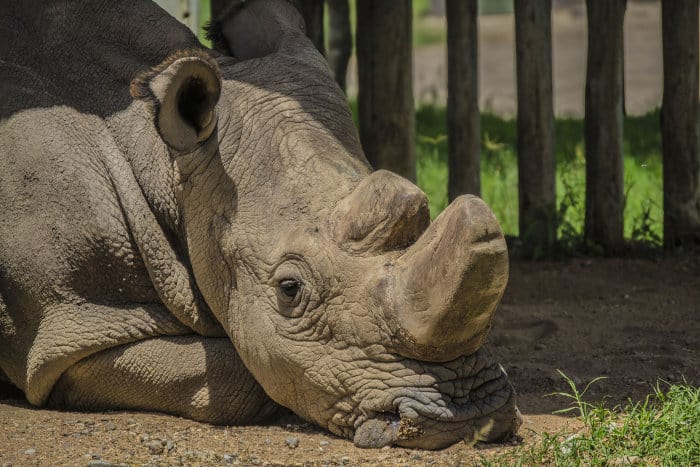
The decline in the numbers of most African wildlife species is linked to the arrival of Europeans. Large herbivores were hunted on mass, partly for trophies, but mostly because they posed a threat to plantations.
At the turn of the 20th century there were hundreds of thousands of black rhinos in Africa. It is estimated that there were tens of thousands of northern black rhinos just a century ago.
The subsequent massacre of rhinos, hippos, elephants, and other great animals cannot be blamed on the African people. They had lived side by side with wildlife for millennia. Although some tribes hunted animals, they did so for food and used every part of the animal.
Rhinos were initially hunted on mass because they were pests that ate crops. Mega grazers like rhinos hurt the profitability of plantations.
All this rampant hunting decimated the wildlife population and left it rife for exploitation.
Things got really bad during the 1960s and 1970s, when the value of rhino horn and elephant ivory rose significantly. Horns and tusks had a price tag. Poaching was widespread and normalised.
The black rhino population dropped from 70,000 in 1970 to 2,400 in 1995. That’s a decline of 96% in 25 years.
The northern white rhino population dropped from 2000 in 1960 to 500 in 1975. By 1985 only 30 of these rhinos were left in the wild.
By 1985, northern white rhinos were already extinct in Sudan, Uganda and the Central African Republic.
A tiny population remained in what is now Garamba National Park, in the Democratic Republic of Congo. This area descended into a war zone with both sides poaching rhinos and elephants to raise funds for weapons.
By 2005 northern white rhinos were extinct in the wild.
Northern White Rhinos in Captivity

Poachers were paid for delivering the rhino horn of dead rhinos. You have probably seen the images of dead rhinos with their horns chopped off by chainsaws, or some other crude method. Again, don’t blame the African people because poaching is driven by demand, not supply.
Poachers were also paid for poaching live rhinos.
Dvůr Králové Zoo received six northern white rhinos from Sudan in 1975. These were captured from the wild and transported to live in captivity in a Czech Republic zoo. One of these was called Sudan, who would later become the last male member of his species.
San Diego Zoo Safari Park once had a population of eight northern white rhinos caught from the wild in Sudan (it’s no wonder these rhinos were soon extinct in Sudan).
It’s worth drawing a parallel to the history of mountain gorillas, another resident of Central African forests. During the 1960s and 1970s, zoos across Europe and the United States invested huge money in attempts to start a captive mountain gorilla population.
Poachers killed adult gorillas to obtain live babies. But don’t blame the poachers. Blame the people and zoological organisations paying for this madness.
When it became clear that northern white rhinos were extinct in the wild, the captive rhinos were returned to the wild and Ol Pejeta Conservancy in Kenya. The hope was for these rhinos to breed and recover.
However, the rhinos arrived with stunted horns, caused by continual rubbing against the sides of enclosures. They had spent a lifetime being hand fed in captivity and now they had to adapt to a wild ecosystem.
It is amazing that these rhinos even survived the journey, never mind the change in habitat and lifestyle. Unfortunately, all attempts at breeding were unsuccessful.
In 2018 the death of Sudan made world headlines. As the only male he carried the survival of a species on his (very broad) shoulders. But the move to Kenya didn’t improve Sudan’s sexual appetite and now the species is extinct.
Captive Mating Attempts Were Doomed to Fail

So the world was sad, for about a day. People made jokes. What a useless rhino! Survival of the species and he didn’t even want to have sex! If they can’t f*** to save themselves then there is no hope!
Let’s look behind the headlines, instead of continuing with the bad jokes from Twitter.
During mating season, both male and female northern white rhinos aim to have multiple mates. This increases their chance of breeding successfully. They release pheromones to attract each other and generally turn the savannah into a horny frenzy.
Captive rhinos are kept in enclosures. Usually they are kept apart from each other. They certainly don’t have opportunity to breed with multiple mates at a time dictated by nature.
Sudan only had two potential mates in Ol Pejeta Conservancy. One was his daughter. The other was his granddaughter.
Yep, in a fact conveniently overlooked by the media and all the jokes, Sudan could mate with either Najin or Fatu. Najin is the biological daughter of Sudan. Fatu is the daughter of Najin, making her Sudan’s granddaughter.
Male northern white rhinos reach sexual maturity around ten years of age. They are in their sexual prime aged 15-20. Sudan was 40 years old when the survival of the species rested on his shoulders. Most wild male white rhinos only live to 40 years old!
Captive white rhinos usually only live to 30, so Sudan was already on borrowed time. And then the world expected him to have sex with his daughter or granddaughter!
So here are some interesting questions. Would you have sex with your offspring to save the human race? If you did, do you think it would be successful? And if you wanted to, could you do it at the age of 90?
The truth with the northern white rhino is that humans destroyed a species. Then they placed an ageing captive male in an enclosure with his daughter and granddaughter, hoping they would have sex and produce fertile offspring.
Is there any end to the stupidity of this story?
Would an IVF Rescue be a Good Thing?

It has since been discovered that both Najin and Fatu are infertile.
After all the jokes died down another option emerged. Scientists are proposing IVF as a last resort.
A store of northern white rhino sperm exists, but “conservationists are divided about how it should be used.”
Scientists are also exploring the possibility of using frozen tissue to generate stem cells that can develop into eggs and sperm, thereby cloning the species.
Creating hybrid white rhinos is considered more achievable, so they aim to cross-breed southern white rhinos with Najin and Fatu using artificial insemination.
But is an IVF rescue a good thing? How much further do humans want to manipulate a species that could have thrived if there wasn’t any human intervention in the first place?
Why do we want an IVF rescue? So we can take photos of cloned rhinos in an enclosure and post them to Instagram?
Perhaps the legacy of Sudan and the northern white rhino is something far greater. This species represents mankind’s rampant impact on nature and a world we left behind.
It is no use keeping a species artificially alive for our own personal gratification. Look what we can do, we can bring rhinos back from extinction! All praise science and humankind!
Surely resources and funds will be better used on preserving the rhino species that remain?
The Plight of Other Rhino Species

So what is left now the northern white rhino is gone.
Poachers still make incredible profit from rhinos. Their horns sell for $75,000 per kg, driven by high consumer demand in countries like China and Vietnam. Here it is believed that the keratin-rich horns can make people look younger and cure disease. It is also considered an aphrodisiac.
Keratin is just gelatinous hair, so eating rhino horn is like biting your fingernail.
Southern white rhinos are one of Africa’s major conservation success stories. Rampant poaching left their population at less than 5000 in the 1970s. The total population now exceeds 20,000.
However, an average of three southern white rhinos are poached and killed, every single day.
The Indian greater one-horned rhino has also recovered. In 1900 less than 200 remained. Now there are 3,500 living in protected areas of India and Nepal. Expanding their habitat will be essential to increasing their population further.
Less than 80 Sumatran rhino are left in the wild. Poaching and habitat destruction continue.
Less than 70 Javan rhinos remain. Incredibly, this number is an increase from ten years ago. This is a single population living in Ujung Kulon National Park, Indonesia.
Black rhino populations are recovering and their current wild population has risen above 5000 individuals.
However, one of the four black rhino subspecies is now extinct. Like the northern white rhino, the western black rhino is extinct. None have been seen since 2003 and the IUCN declared their extinction in 2006.
What is Next for Rhino Conservation?
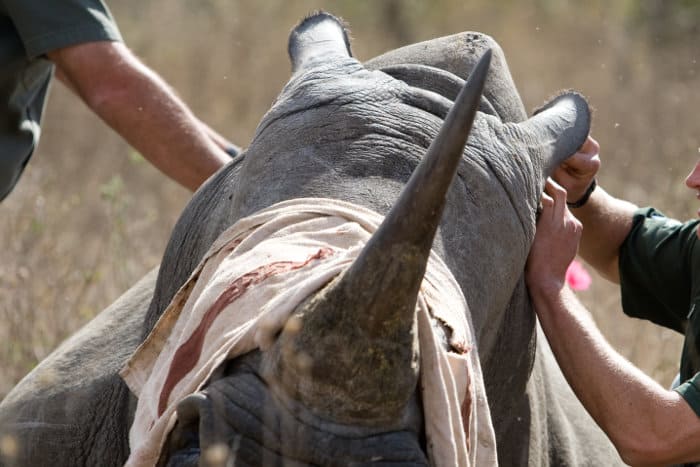
Perhaps we need a new approach to wildlife conservation. The current focus is centred on conserving specific animals and species. Some are endangered so they get more help. Many others can still be killed, legally.
Humans continue to make decisions about which animals we can eat, hunt, protect and preserve. But humans didn’t do any good for northern white rhinos, so why don’t we leave nature to do its own thing.
Animals will survive if we preserve the places where they live.
Animal populations will recover if we preserve the natural habitat, without any fancy science or IVF.
So let’s think about the wilderness. The animals have been around for longer than us. And if they have the space and habitat they will thrive once more.



